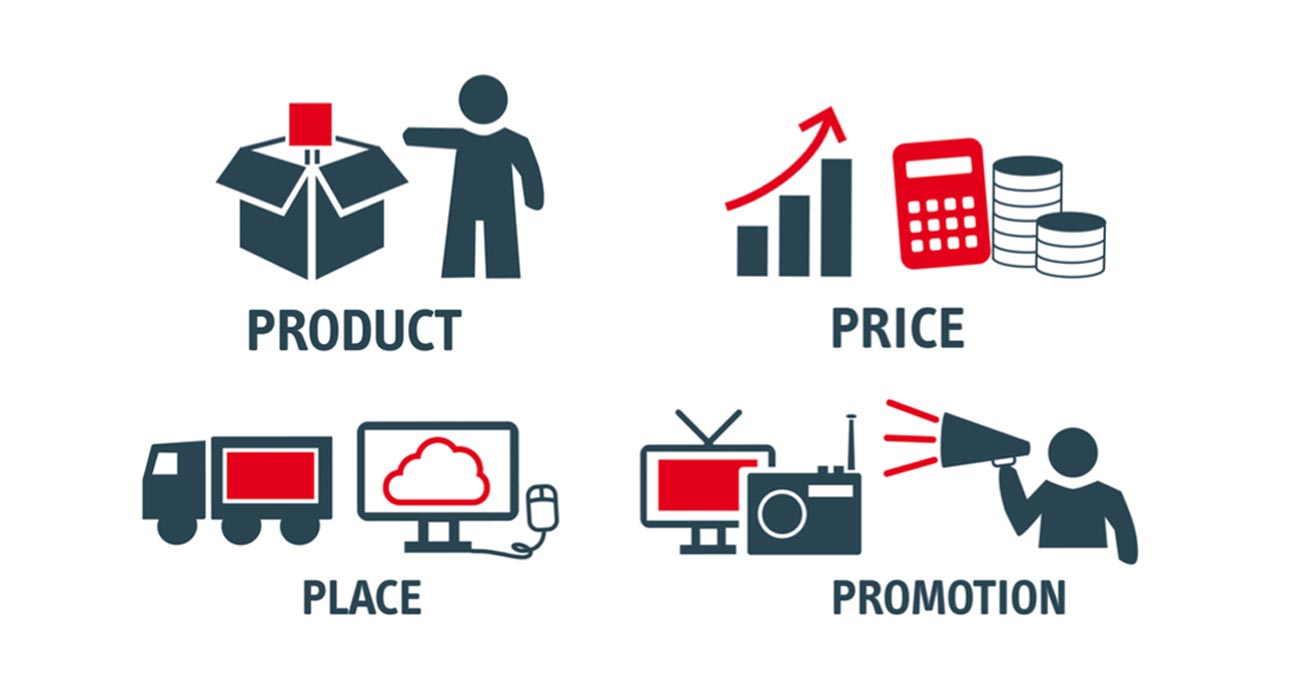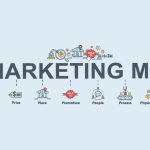The “4 Ps of Marketing Mix” refer to the four key elements comprising the process of marketing a product or service. They involve the marketing mix, which is a set of tools that a company uses to influence consumers into buying its product.
The marketing mix addresses factors such as:
- Understanding the needs or desires of consumers
- Identifying the cause of the failure of the current product offering
- Finding ways to solve said problems and change public perception of the product/service
- Creating distinguishing characteristics to increase competitive advantage
- Understanding how the product interacts with consumers and vice versa
Marketing mix” is a general phrase used to describe the different kinds of choices organizations have to make during the process of bringing a product or service to market.
The 4Ps is one way – probably the best-known way – of defining the marketing mix, and was first expressed in 1960 by E. J. McCarthy in his book, “Basic Marketing – A Managerial Approach.”

4 Ps of Marketing Mix
The four Ps of marketing are:
-
- Product: What you sell. Could be a physical good, services, consulting, etc.
- Price: How much do you charge and how does that impact how your customers view your brand?
- Place: Where do you promote your product or service? Where do your ideal customers go to find information about your industry?
- Promotion: How do your customers find out about you? What strategies do you use, and are they effective?
Over time many Ps have been crystallized like 5Ps, 8Ps, etc. But the 4Ps of marketing are like the purest crystal which cannot be refined further. Every other Ps-model is either an expansion or modification of the original 4Ps.
Often the three additional Ps– process, people, and physical evidence is also added and called the 7 Ps of Marketing.
4 Ps of Marketing Mix
#1: Product:
The product is the good or service being marketed to the target audience.
Generally, successful products fill a need not currently being met in the marketplace or provide a novel customer experience that creates demand.
For example, the original iPhone filled a need in the market for a simplified device that paired a phone with an iPod.
As you are working on your product, it is essential to consider your target audience and their unique needs.
Some questions to consider when working on a product include:
- What is your product?
- What does your product do? Does the product meet an unfilled need or provide a novel experience?
- Who is your product’s target audience?
- How is your product different from what others offer?
- How and where will the customer use it?
- What does it look like? How will customers experience it?
- What size(s), color(s), and so on, should it be?
- What is it to be called?
- How is it branded?
- How is it different from products by your competitors?
#2: Price:
Price is the cost of a product or service.
When marketing a product or service, it is important to pick a price that is simultaneously accessible to the target market and meets a business’s goals.
Pricing can have a significant impact on the overall success of a product.
For example, if you price your product too high for your targeted audience, then very few of them will likely purchase it.
Similarly, if you price your product too low, then some might pass it up simply because they are concerned it might be of inferior quality and cut into your potential profit margins.
To identify a successful price, you will want to thoroughly understand your target audience and their willingness to pay for your product.
Some questions you might ask yourself as you are considering your product’s price include:
- What is the value of the product or service to the buyer?
- Are there established price points for products or services in this area?
- What price best fits your target market?
- What is the price range of your product’s competitors?
- What is the price range of your target audience?
- What price is too high for your audience? What price is too low?
- What discounts should be offered to trade customers, or to other specific segments of your market?
4 Ps of Marketing Mix
#3: Place
Place is where you sell your product and the distribution channels you use to get it to your customer.
Much like price, finding the right place to market and sell your product is a key factor in reaching your target audience.
If you put your product in a place that your target customer doesn’t visit—whether on or offline— then you will likely not meet your sales target.
The right place, meanwhile, can help you connect with your target audience and set you up for success.
For example; imagine you are selling an athletic shoe you designed. Your target market is athletes in their early twenties to late thirties, so you decide to market your product in sports publications and sell it at specialty athletics stores.
By focusing on sports stores over shoe stores in general, you are targeting your efforts to a specific place that best fits your marketing mix.
To decide the best place to market and sell your product, you should consider researching the physical or digital places where your target audience shops and consumes information.
Some questions to consider include:
- Where will you sell your product?
- Where does your target audience shop?
- What distribution channels are best to reach your target market?
- What do your competitors do, and how can you learn from that and/or differentiate?
#4: Promotion
Promotion is how you advertise your product or service. Through promotion, you will get the word out about your product with an effective marketing campaign that resonates with your target audience.
There are many different ways to promote your product. Some traditional methods include word of mouth, print advertisements, and television commercials.
In the digital age, though, there are even more marketing channels that you can use to promote your product, such as content marketing, email marketing, and social media marketing.
Some questions to consider as you are working on your product promotion include:
- What is the best time to reach your target audience?
- What marketing channels are most effective for your target audience?
- What advertising approaches are most persuasive to your target audience?
- How do your competitors do their promotions? And how does that influence your choice of promotional activity?
Alternative Marketing Mix Tools
The five Ps of Marketing Mix
The five Ps are product, price, place, promotion, and people.
Today, many marketers use the five Ps over the four Ps because it centers the experiences of customers and staff in the marketing process.
Typical considerations include how a customer behaves, their experience with the product, and their overall satisfaction with the business.
The 7 Ps of Marketing Mix
The 7 Ps of the marketing mix is an extended, modified version of the 4 Ps of marketing. This model is widely used in the service industry. It adds 3 more elements to the 4 Ps discussed above.
#5: People
This refers to the people – both your customers and employees – who are directly related to the product or service.
While you need to study your target market to understand whether they are in need of the type of product you are offering, you need to hire the right people who are capable of giving their best to build it.
#6: Process
Systems and processes play an important role in building and delivering a quality service to your customer.
Make sure that your process is free of bottlenecks and blockers in order to reduce the unnecessary expenses associated with executing the service.
#7: Physical Evidence
Physical evidence refers to what the customers see when consuming your product or service. This could include your branding, packaging, the physical environment where you are selling your product, etc.
Make sure that all physical aspects associated with your product or service adhere to its values.
Conclusion
The four Ps of marketing—product, price, place, and promotion—are often referred to as the marketing mix. These are the key elements involved in planning and marketing a product or service, and they interact significantly with each other.




